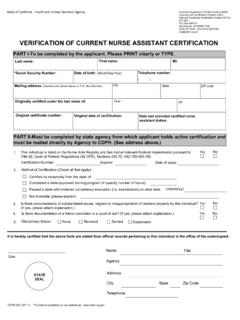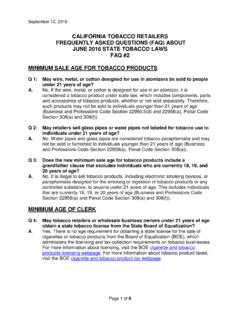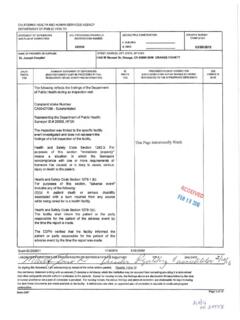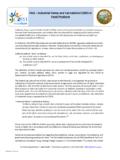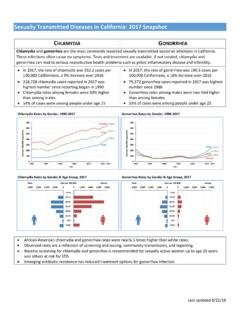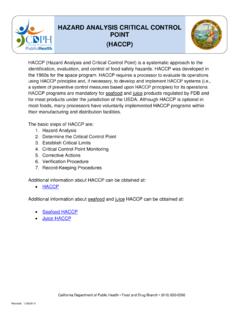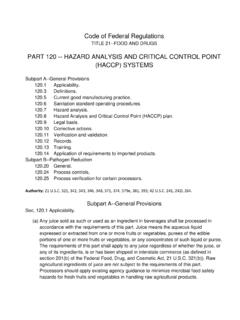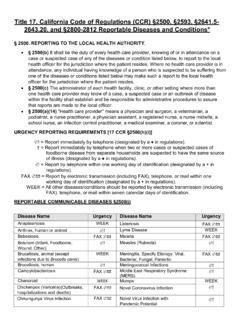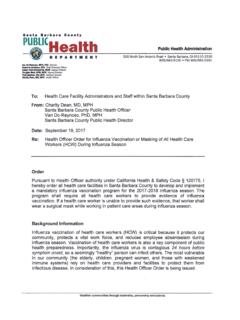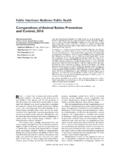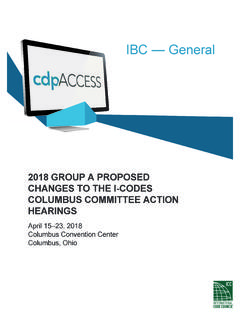Transcription of Compendium of Surveys - cdph.ca.gov
1 Last Updated September 9, 2017 Compendium of Surveys For Nutrition Education and Obesity Prevention Compiled by the Research and Evaluation Section The Network for a Healthy California California Department of Public Health Funded by the US Department of Agriculture Supplemental Nutrition Assistance Program This material was produced by the California Department of Public Health s Nutrition Education and Obesity Prevention Branch with funding from USDA SNAP, known in California as CalFresh (formerly Food Stamps). These institutions are equal opportunity providers and employers. CalFresh provides assistance to low-income households and can help buy nutritious foods for better health. For CalFresh information, call 1-877-847-3663. For important nutrition information, visit 1 TABLE OF CONTENTS Compendium of Surveys Preface Chapter 1 Required Surveys for Impact Outcome Evaluation Section Youth Nutrition and Physical Activity Surveys Youth Nutrition and Physical Activity Survey- English Youth Nutrition and Physical Activity Survey Survey- Spanish Youth Nutrition and Physical Activity Survey Administration Protocol Section High School Nutrition and Physical Activity Survey High School Nutrition and Physical Activity Survey High School Nutrition and Physical Activity Survey Administration Protocol Section Adult Surveys Food Behavior Checklist- English Food Behavior Checklist- Spanish Food Behavior Checklist- Chinese Food Behavior Checklist Instruction Guide Fruit and Vegetable Checklist- English Fruit and Vegetable Checklist- Spanish Fruit
2 And Vegetable Checklist Instruction Guide Section Preschool Survey What Does Your Child Eat Summary What Does Your Child Eat Survey- English Chapter Assessment of Nutrition and Physical Activity Supports Section Assessment of Nutrition and Physical Activities Supports Assessment of Nutrition and Physical Activities Supports Summary Assessment of Nutrition and Physical Activities Supports Survey Chapter 2 Children s Surveys Section Diet SPAN 4th, 8th, 11th Grade Surveys SPAN Student Survey- English SPAN Student Survey- Spanish SPAN Student Survey Administration Protocol Section Availability of Fruits and Vegetables Availability at School Availabilty at Home Section Power Play! School and Idea Resource Kit (SIRK) Survey 2 Section Food Preference Survey English Spanish Section Knowledge Surveys General Knowledge Survey Hawthorne Unified School District Student Knowledge Survey Section Social and Family Norms Surveys Social Norms Family Norms Section Outcome Expectations Outcome Expectation Description and Survey Section Fruit and Vegetable-Related Self-Efficacy Surveys Eating, Asking, Preparing- English Eating, Asking, Preparing- Spanish Eating- English Asking and Shopping- English Section Beverage and Snack Questionnaire Section Food Security and Food Assistance Surveys Section Youth Risk Behavior Surveillance 2011.
3 Physical Activity Questions for Middle School Section Physical Activity Preferences Survey Section Youth & High School Demographics Chapter 3 Surveys for High School Students Section School Physical Activity and Nutrition Survey (SPAN) 11th Grade English Spanish Section Youth Risk Behavior Surveillance 2011 (YRBS) Fruit and Vegetable Questions Section National Youth Physical Activity and Nutrition Study (NYPANS) Beverage Checklist Section Beverage and Snack Questionnaire Beverage and Snack Questionnaire Summary Beverage and Snack Questionnaire Survey Sample Section Knowledge Surveys Section Youth Risk Behavior Surveillance 2011 (YRBS) Physical Activity Questions Section National Youth Physical Activity and Nutrition Study (NYPANS) Physical Activity Factors Section Physical Activity Preferences 3 Section Youth and High School Demographicds Chapter 4 Surveys for Adults Section Measures of Fruit and Vegetable Consumption for Adults NCI All Day Screener NCI By Meal Screener Behavioral Risk Factor Surveillance System- Fruit and Vegetable Module Food Attitude Behaviors- Cups of Fruits and Vegetables Survey Section Fruit and Vegetable Inventory Fruit and Vegetable Inventory Summary Fruit and Vegetable Inventory Section Food Preference English English/Spanish Section Psychosocial Factors/Healthy Eating Psychosocial Factors/Healthy Eating Summary Psychosocial Factors/Healthy Eating Survey Section Support for Healthy Eating Work Home Section Social Norms for Healthy Eating
4 Section Support for Buying Fruits and Vegetables Section Fruit and Vegetable Shopping Practices Section Cooking Attitudes and Self-Efficacy Section In Home Availability of Fruits and Vegetables Section Neighborhood Food Access Section Food Security and Food Assistance Section Physical Activity On the Go!- English/Spanish On the Go! Instruction Guide Rapid Assessment of Physical Activity- English Rapid Assessment of Physical Activity- Spanish Section Physical Activity Preference Section Social Support for Physical Activity Section Adult Demographics Adult Demographics Summary Adult Demographics Survey- English Adult Demographics Survey- Spanish 4 Chapter 5 Program and Materials Evaluations Section Formative Evaluation Feedback Group Moderator Guide Formative OnetoOne Example Formative SAQ Example Section Regional Collaborative Train-the-Trainer Evaluation Regional Training Plan Final Training Evaluation Post SurveyMonkey Questions Section Case Study Guidelines a.
5 Preface This Compendium of survey instruments was compiled to measure change in consumption of fruits, vegetables, and other foods; physical activity; food security and factors that influence those behaviors. It was compiled for members of the Network for a Healthy California, a group of organizations delivering nutrition education interventions to low-income residents throughout California. This Compendium contains tools for evaluating programs working with children, teens, and adults. Some of the Surveys contained within the Compendium have been validated and should not be modified. Others are designed to be modified to reflect the specific items targeted by the intervention. It is best to begin evaluating intervention effectiveness by measuring change in two or three factors, like knowledge, preferences or self-efficacy.
6 Once there is evidence that the intervention is making a difference at some level, it is appropriate to measure more factors and behaviors. Guidance should be sought if the Surveys are used by individuals with little program evaluation experience to ensure data are collected using sound methods that will give findings credibility. The Research and Evaluation Section of the Nutrition Education and Obesity Prevention Branch wishes you the best of luck. Evaluation of field-based nutrition education interventions is needed and we hope this Compendium helps fill that gap. Chapter 1: Required Surveys for Impact Outcome Evaluation The tools summarized in this chapter are required Surveys for Local Health Departments participating in Impact/Outcome Evaluation (IOE). Local projects should select the appropriate survey based on the target age population of the intervention being evaluated.
7 Projects participating in IOE are encouraged to consider using supplemental tools from other chapters of this Compendium in addition to a required survey when such tools would augment the evaluation of intervention objectives. 1 Youth Nutrition and Physical Activity Survey What are the behaviors/issues being measured? These questions measure availability and food consumption. Availability is self-reported perceptions that fruits and vegetables are present and accessible in the home. Food Consumption is the times per day that respondents report eating specific foods or beverages. The Youth Nutrition and Physical Activity Survey is a condensed version of the School and Physical Activity Nutrition project (SPAN) survey (Hoelscher, Day, Kelder, & Ward, 2003) for fourth through eighth graders.
8 The SPAN project validated one survey for 4th graders2,3 and one for eighth In order for contractors to use the same survey with all students, the assumption is made that an 8th grader can complete a survey written at a lower reading level. The 8th grade SPAN survey questions are at a higher reading level ( reading level), but the Network used the 4th grade survey ( reading level)1 to have consistent data across a school site. Each question on the SPAN food behavior module was validated for fourth graders (children aged 9-11) in classroom settings,2,3 and showed moderate to substantial agreement in kappa It also showed substantial agreement in kappa scores for all measures when tested for The same three fruit and vegetable consumption questions on SPAN were also validated with 8th graders by Hoelscher et al.
9 (2003)1 and found to have substantial agreement based on their kappa scores. The fruit and vegetable questions were each slightly modified to allow up to 5 or more times per day for consumption to be consistent with the current recommendation which was increased in 2005 to 3-5 cups per day (about 6-10 servings) for 9-12 year old This survey also includes several questions on availability of fruits and vegetables from Hearn et and is available in English and Spanish. With this instrument, typically a sample size of 100 is needed to detect a cup change from pre to post. A sample size of 200 will detect a 1/4 cup change from pre to post. Who is the target audience? Many SNAP-Ed contractors organize interventions by school site and evaluate interventions in a range of elementary-school grades, which can go up through 8th grade in California.
10 References 1. Hoelscher DM, Day RS, Kelder SH, Ward JL. Reproducibility and validity of the secondary level School-Based Nutrition Monitoring student questionnaire. J Am Diet Assoc. Vol 103; 2003:186-194. 2 2. Thiagarajah K, Bai Y, Lo K, et al. P102 Assessing Validity of Food Behavior Questions from the School Physical Activity and Nutrition Questionnaire. Journal of Nutrition Education and Behavior. 2006;38(4):S55-S56. 3. Thiagarajah K, Fly AD, Hoelscher DM, et al. Validating the food behavior questions from the elementary school SPAN questionnaire. J Nutr Educ Behav. Sep-Oct 2008;40(National Cancer Institute & 5 a Day Program Evaluation Group):305-310. 4. Munoz S, Bangdiwala S. Interpretation of kappa and B statistics measures of agreement. J Appl Stat. 1997;24:105-111. 5. Penkilo M, George GC, Hoelscher DM.

